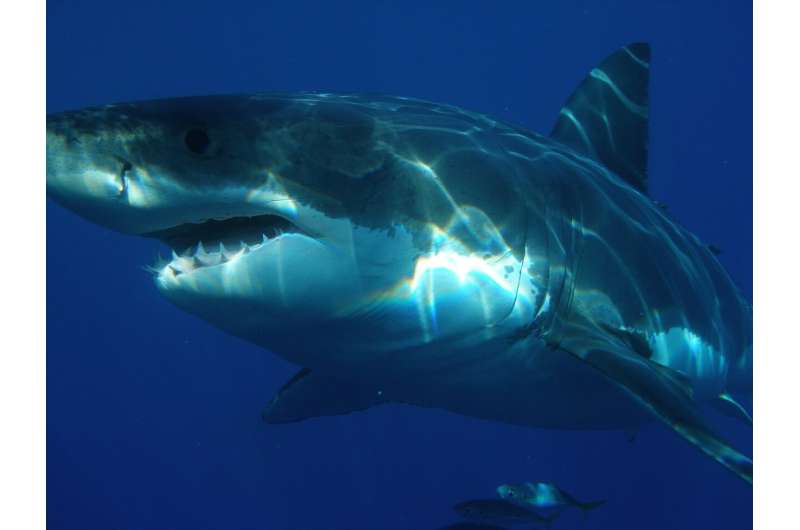Great white shark numbers increasing off Northern California coast

You're still far more likely to see them in movies or TV shows than in person, but the number of great white sharks appears to be increasing along the Northern California coast, say scientists who tracked hundreds of the toothy predators by their distinctive fins.
The exhaustive new study concluded there are nearly 300 adult and sub-adult white sharks living between Monterey Bay, the Farallon Islands and Bodega Bay, an area sometimes called "the red triangle." Sub-adult sharks are not fully mature but still big enough to eat seals, sea lions and other marine mammals.
That's a modest increase from 10 years ago, researchers say, and a clear indication that ocean conditions in the area are generally trending in the right direction.
"A healthy population of white sharks means there are healthy populations of the sea lions and elephant seals they eat," said Paul Kanive, a marine ecologist with Montana State University and lead author of the study. "And that means that the lower levels on the food chain, like fish, are healthy enough to support the marine mammals."
With hundreds of sharp, triangular teeth, and the ability to swim 35 mph, great whites are amazing hunters. They can grow up to 20 feet long and weigh more than 4,000 pounds. For generations they have been mysterious, and often feared. Scientists knew little about how many there were, where they swam, or their mating habits. Most people learned about great whites from movies like "Jaws," which sensationalized their threat to humans.
But in recent years, researchers at Stanford University and the Monterey Bay Aquarium, two institutions that funded the latest research, have put electronic tags on the massive sharks, tracking their movements. They have worked with scientists from other research centers to photograph individual sharks and compile databases of their numbers—a family album of marine macro-predators.
For the latest study, marine biologists worked in boats from 2011 through 2018 off Southeast Farallon Island, Ano Nuevo Island along the San Mateo County coast, and Tomales Point in Marin County.
Over 2,587 hours, the scientists collected photographs from above the water and underwater. To lure white sharks to their boat, they put a small amount of seal meat in the water to create a scent. Then, they drew the sharks closer with a seal decoy made of black carpet and tied to the boat with a fishing line.
The scientists captured more than 1,500 photographs, focusing on the jagged edge of the sharks' famous top fin.
"Every white shark has a unique dorsal fin. It's like a fingerprint or a bar code," said Taylor Chapple, an assistant professor of fisheries and wildlife at Oregon State University, and co-author of the study. "It's very distinct."
As part of a similar study published in 2011, researchers estimated that there were 219 adult and sub-adult great white sharks in the same area off Northern California, with a possible range of 130 to 275. But the latest study estimates that as of 2018, there were 266 white sharks, with a possible range of 218 and 313.
There are probably three reasons for the increase in numbers, experts say. First, President Richard M. Nixon signed the Marine Mammal Protection Act in 1972. That ended the hunting of seals, sea lions, elephant seals and other animals that sharks eat, sending their numbers soaring.
Second, California lawmakers banned the killing of white sharks in state waters out to three miles in 1994. And finally, California voters ended gillnet fishing in state waters when they passed Proposition 132 in 1990. Gillnets are large nets that can often kill sharks, dolphins, turtles and other marine life accidentally during commercial fishing.
But white sharks still face threats. They live along the Northern California coast from September to February, then swim 1,500 miles each way to an area between Hawaii and Mexico called "the Shark Cafe," where they congregate, eat and are believed to mate. While in the open ocean they are at risk of being killed by long-lines and other high seas fishing practices.
The new study found that 60% of the sharks off Northern California were males, and 40% were females, leading to other concerns.
"Losing just a few animals can be really critical to the larger population," said Kanive, who set up a GoFundMe account to help fund the research after other funding fell short. "It's important that we continue to protect them and their surroundings."
Do more sharks mean more people are at risk of attack? Probably not, experts say.
In one tragic interaction last May, surfer Ben Kelly, 26, of Santa Cruz, was bitten 100 yards off Manresa State Beach in Aptos. The bite occurred behind his right knee, hit an artery and he bled to death. An investigation by state wildlife biologists found the shark was at least 10 feet long, bigger than the juveniles that have increasingly congregated in the area as waters have warmed.
But the risk generally of being injured or killed by a great white shark off California is tiny. A study published by Stanford scientists in 2015 found a 1-in-17 million risk of a surfer being attacked by a white shark off California. The risk fell 91% from 1950 to 2013, the scientists found, because the number of attacks remained mostly constant, but the human population in coastal California tripled from 7 million in the 1950s to 21 million in 2013.
"The probability of people encountering a white shark is very low," Kanive said. "It's a very rare event."
MediaNews Group, Inc.
Distributed by Tribune Content Agency, LLC.





















